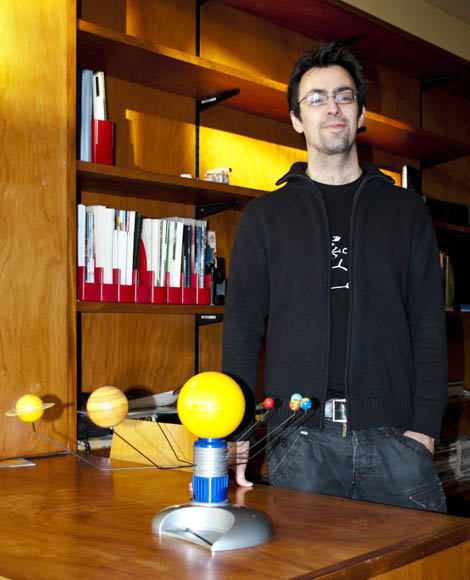 A team of researchers from the Center for Astrophysics of the University of Porto (CAUP), led by the Alentejo astronomer Pedro Figueira (born in Serpa), and from the Geneva Observatory, analyzed data from the HARPS spectrograph and the Kepler satellite, demonstrating that the orbits of others planetary systems are aligned, just as in our Solar System.
A team of researchers from the Center for Astrophysics of the University of Porto (CAUP), led by the Alentejo astronomer Pedro Figueira (born in Serpa), and from the Geneva Observatory, analyzed data from the HARPS spectrograph and the Kepler satellite, demonstrating that the orbits of others planetary systems are aligned, just as in our Solar System.
The search for exoplanets is currently carried out essentially by two different methods: the radial velocity method and the transit method. There is a significant difference when these two methods are applied.
A planet can be detected by varying the star's radial velocity even when its orbit is tilted relative to our line of sight. However, for a planet to transit, its orbit plane must be almost perfectly aligned with Earth, and the same is true for a system of two or more planets. This means that if we observe several planets transiting a planetary system their orbits will make very small angles to each other.
In this work now published, 100 million planetary systems were simulated with the characteristics predicted by the HARPS census and with variable dispersion of the orbital planes. The simulation calculated the frequencies with which transits, in particular double transits, occur.
The results were compared with the data obtained by Kepler and it was concluded that they are compatible only in systems with a common orbital plane, that is, in which the orbits of the planets are inclined less than 1 degree from each other.
The results now published are very important for understanding the mechanism of formation and evolution of extrasolar planets, showing that planetary orbits are predominantly aligned, reinforcing the idea that planets form in a disk around stars and greatly limit their evolution dynamic, violent encounters between planets are very rare. The order we find in our solar system is after all a rule.
The first author of the article, Pedro Figueira comments that “these results show us that the way the Solar System was formed must be common. Its structure is the same as that of the planetary systems we studied, that is, with the planets all orbiting approximately on the same plane”.
This is the result of a study, led by astronomer Pedro Figueira, from the Center for Astrophysics, University of Porto.
Author Ricardo Cardoso Reis
University of Porto Astrophysics Center
(Science in the Regional Press – Ciência Viva)
Notes:
- The article Comparing HARPS and Kepler surveys: The alignment of multiple-planet systems, (FIG tree et al.) has been accepted for publication in the journal. Astronomy & Astrophysics.
- The team is composed of P. fig tree (Center for Astrophysics of the University of Porto), M. Marmier (Observatory of Geneva), G. Boué (Center for Astrophysics of the University of Porto), C. Lovis (Observatory of Geneva), NC Santos (Center for Astrophysics and Faculty of Sciences, University of Porto), M. Montalto (Center for Astrophysics of the University of Porto), S. Udry (Geneva Observatory), F. Pepe (Geneva Observatory), M. Mayor (Geneva Observatory).


















Comments